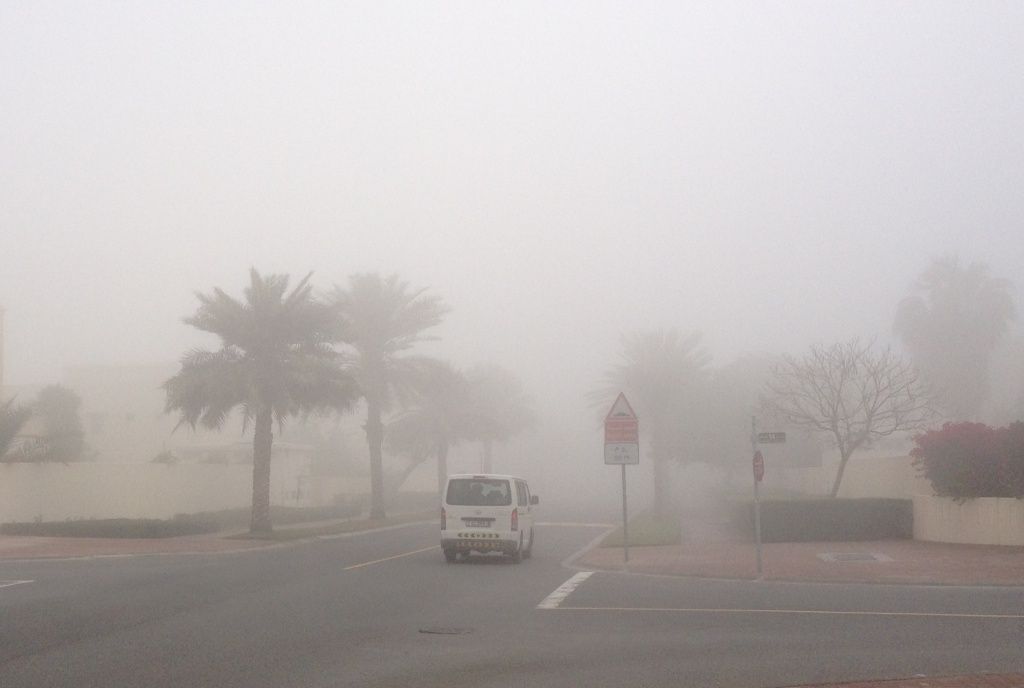
Driving in bad weather in the UAE is often linked to fog, rain or sand storms with low visibility and slippery road surfaces being the common denominators. Every year, we suffer pile-ups which are typically chain reactions: One accident occurs, sometimes just a small fender bender, and following motorists cannot avoid colliding with obstacles in front of them, due to the lack of proper distance, lack of attention or too high speeds.
How to do it right:
- Visibility Down: Slow Down => Attention Up => Distance Up!
- Adjust your speed so you can always stop within the line of visibility … Slow down!
- Concentrate and do not get distracted by your passengers, your phone or other things
- Increase the distance from the 3 seconds in good weather to a minimum of 5 seconds – you must be able to stop within the distance of visibility!
- Turn on the lights: low beam head lights, front and rear fog lights (no hazard lights!)
- Care for others, especially for weaker traffic participants like motor cycle drivers, bicycle riders and pedestrians
- Consider longer braking distances due to wet or slippery road surface
- In rain, reduce your speed to avoid aquaplaning
- Use your windscreen wipers properly (and maintain them properly!), use your heater and A/C to avoid fogging of the wind screen
- Listen to the radio for traffic updates
- Ask your passengers to help keep an eye out for oncoming cars and obstacles on the road
- Stay in your lane and don’t drift – there’s a natural tendency to wander into the middle of the road when visibility gets bad.
- Use the lane marks or the right edge of the road as a guide – this can help you avoid running into oncoming traffic or being blinded by oncoming headlights.
- If you have no visibility, pull over to the side of the road and turning on your hazard lights alert other drivers of where you are, or pull into petrol stations or rest areas.
- Plan your trip properly and leave earlier or try not to be on the road at all, if possible.
Watch out for:
- Do not use hazard lights (they are meant for standing cars in case of an emergency)
- Do not use rear fog lights during normal visibility, since they can blind following drivers and rear fog lights can over-power your brake lights, hence following drivers might not see you braking
- Stay away from areas which are normally affected by bad weather like Wadis
- In case of rain, avoid low lying parts of the roads network like underpasses
Article updated 16-Feb-2021 (previous update 17-Jan-2021; originally published 26-March-2014)
Share your story








A great piece, only a fool forgets the 2 second rule which as your rightly state should be increased to 5 seconds when visibility is low i.e. foggy conditions. I do believe the message regarding the use of hazards is getting out there, after my commute in this morning which was dreadful due to the low visibility I did notice less people driving with their hazard lights on but more still needs to be done. As it gives the wrong message when other motorists see hazards in the distance, believing there is an accident ahead. More training and awareness is needed regarding the use of hazard lights in foggy conditions.
During normal weather condition, the safe distance shall be minimum 3 seconds and not 2 seconds.
In foggy weather, only FOG lights to be used. If headlights are On, the fog in front will act as mirror and reduce your visibility.
Please do not drive very slow in the speed lane, this will cause accidents. If you feel drive slow, please move to slow speed lane
Do not be argent in the road because When you are in the driver seat and driving the car, please remember that you are in the same level and state of the neighboring driver who is in the other lane irrespective of your position or which car you drive.
Please do not drive Zig Zag, you are endangering others life because you are not bothered of yours.
- To make sure there is enough space
- Switch on the light
- Stop at all using Mobile
- Make sure let children seat at back seat with safety built
- speed down
- stop on right side if you feel the weather is not clear enough to avoid having accident
Pingback: Tips to Drive Safely in Bad Weather - CarNewsCafe.com